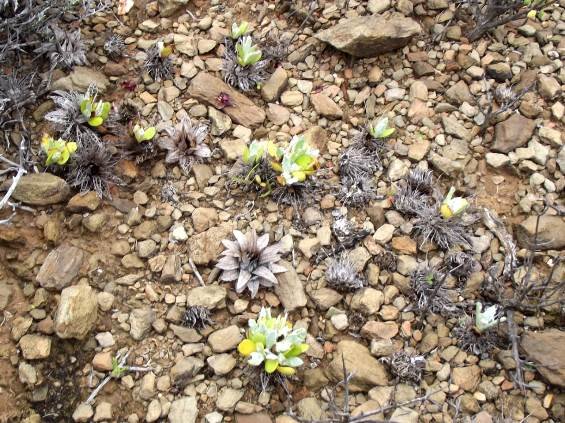Berkheya cuneata seedlings emerging from their cradles

Author: Ivan Lätti
Photographer: Louis Jordaan
Early days for Berkheya cuneata plants in various developmental stages are shown in this gravelly Little Karoo spot. The seed(s) that germinate are retained inside the dry flowerheads that drop off after fruiting. The perennial parent plant does the same again next year.
The flat lower surface of the flowerhead ensures that it stops rolling around once it lands right side up. That is if the wind doesn’t decide otherwise and removes the head yet further, spreading new plants better. Seed dispersal still involves wind, gravity and the contours of the land, as is also the case with the seeds of many other species.
Only here the curious outcome is not achieved by a single seed freed from its encumbrances, travelling light. The whole dry capitula travels intact, depositing all the seeds produced in it at the same destination together. Benefits include shelter and consumable leftovers of the parent plant serving as nourishment. Disadvantages include multiple germinations all in one spot, therefore seed waste and seedling competition.
Some of the seeds probably received more resources during development, rendering them differently equipped for life’s challenges. Weaker seedlings are probably bullied out of existence by stronger siblings, like dominant raptor chicks invariably commit Cain murdering Abel repeats in the nest. Life is so wonderful because it doesnt last so well.
Some of these fruitheads are raided by mice and maybe others among the hungry masses, for feeding the populace is a commitment shared among all species. Life is driven unplanned down random evolutionary routes of numerous deaths.
The key being the timing of death: either before reproduction (for the unfit), or after reproduction (for the fit). Thus life reaches survival solutions of untold variety on earth, the biodiversity safeguarding life itself in whatever form, rather than any particular constituent components.
This composite Asteraceae flowerhead arrived at a workable solution by natural selection of the flowerhead retention option. Cuspidia cernua, a species of a different Asteraceae genus employs the same method.
Wasteful? Evolution is always extremely wasteful in producing all kinds of genetic varieties and then allowing only those fit to meet the challenges of the day to survive. Biodiversity takes time but evolution beats design room outcomes without exception in the land of the living.
The survivors need the nutrition provided by their less fortunate brethren, so a lot of dying is functional, key to the business model employed by all life on earth (Louis Jordaan, personal communication; Shearing and Van Heerden, 2008).

